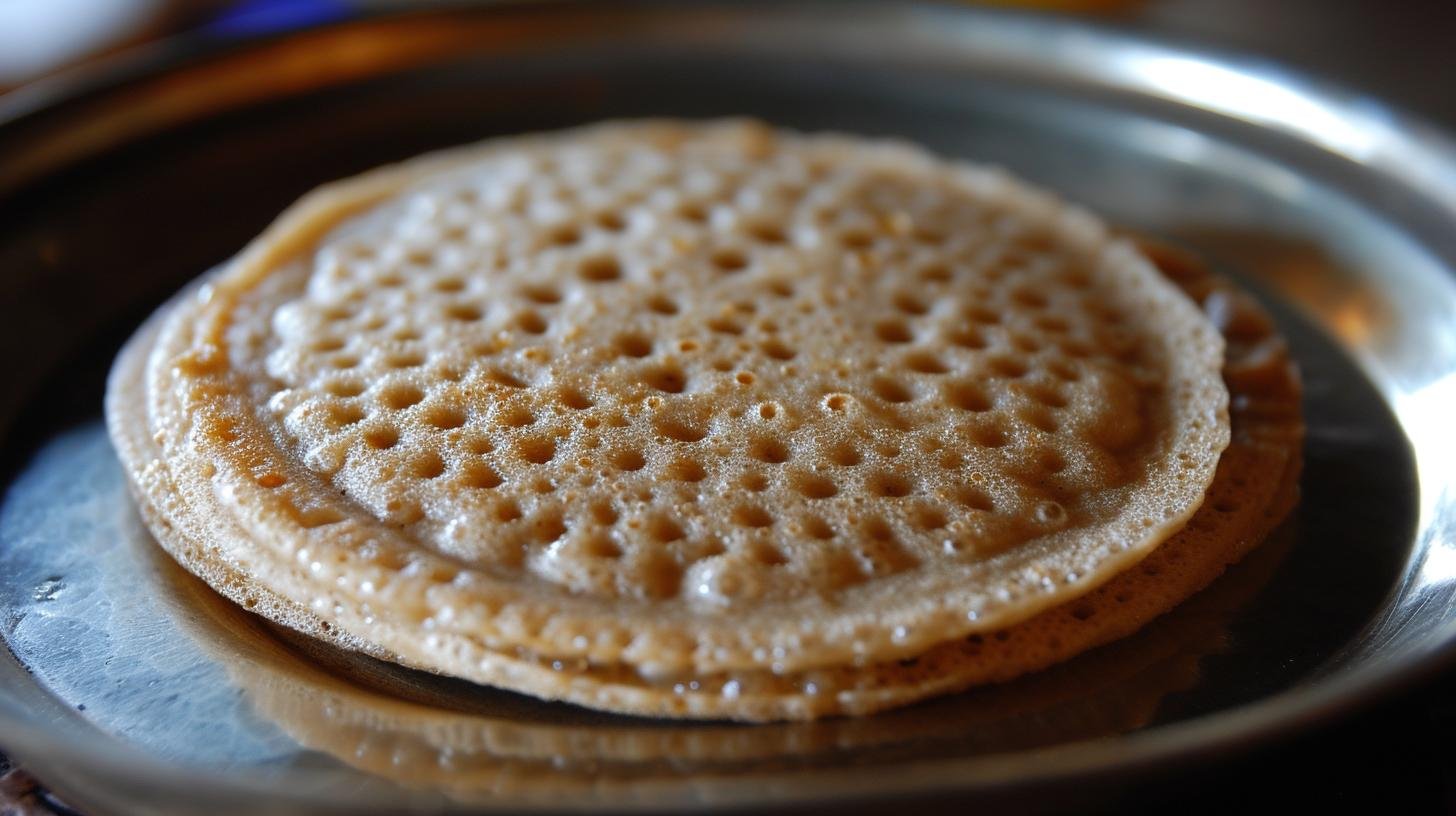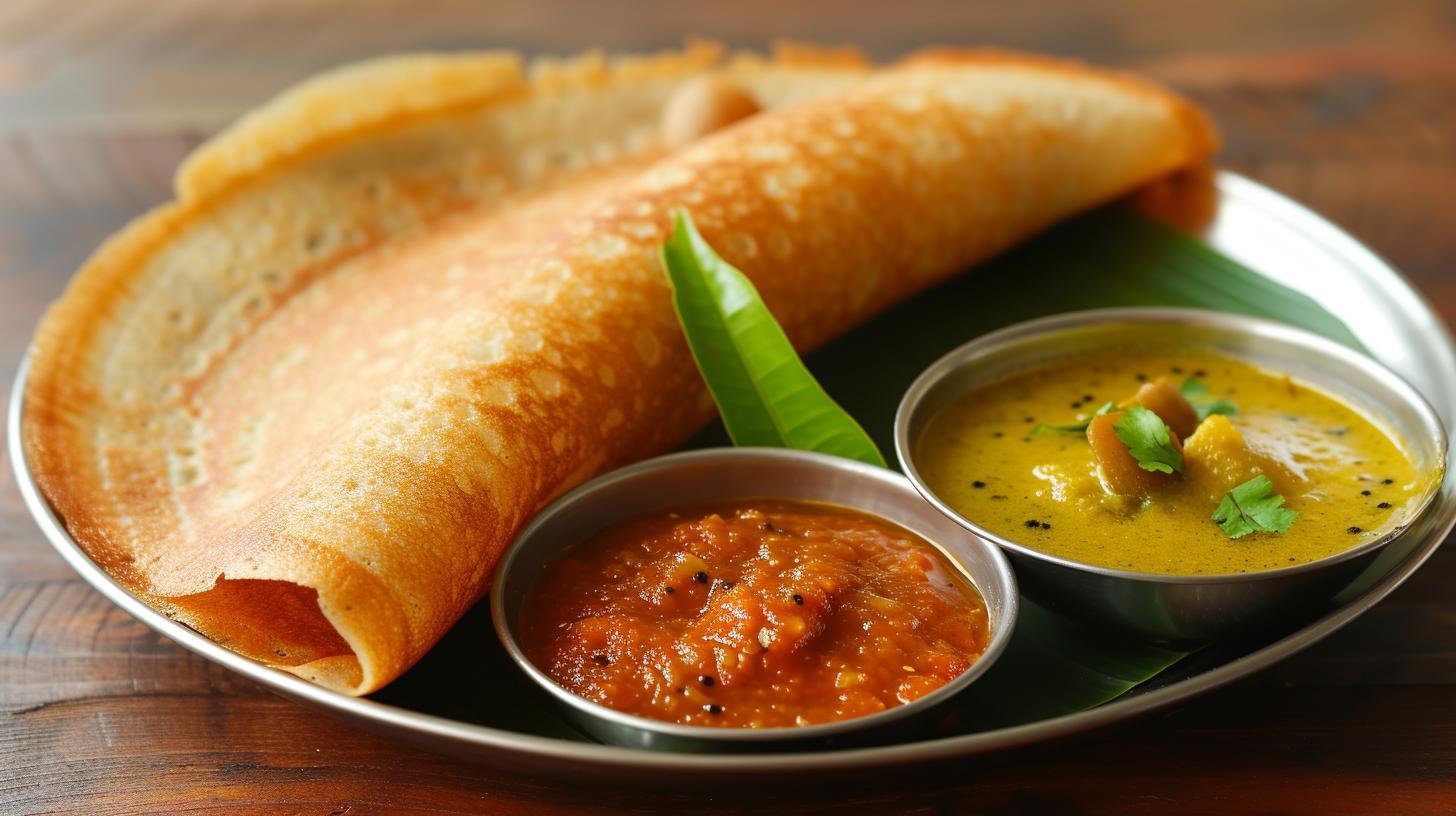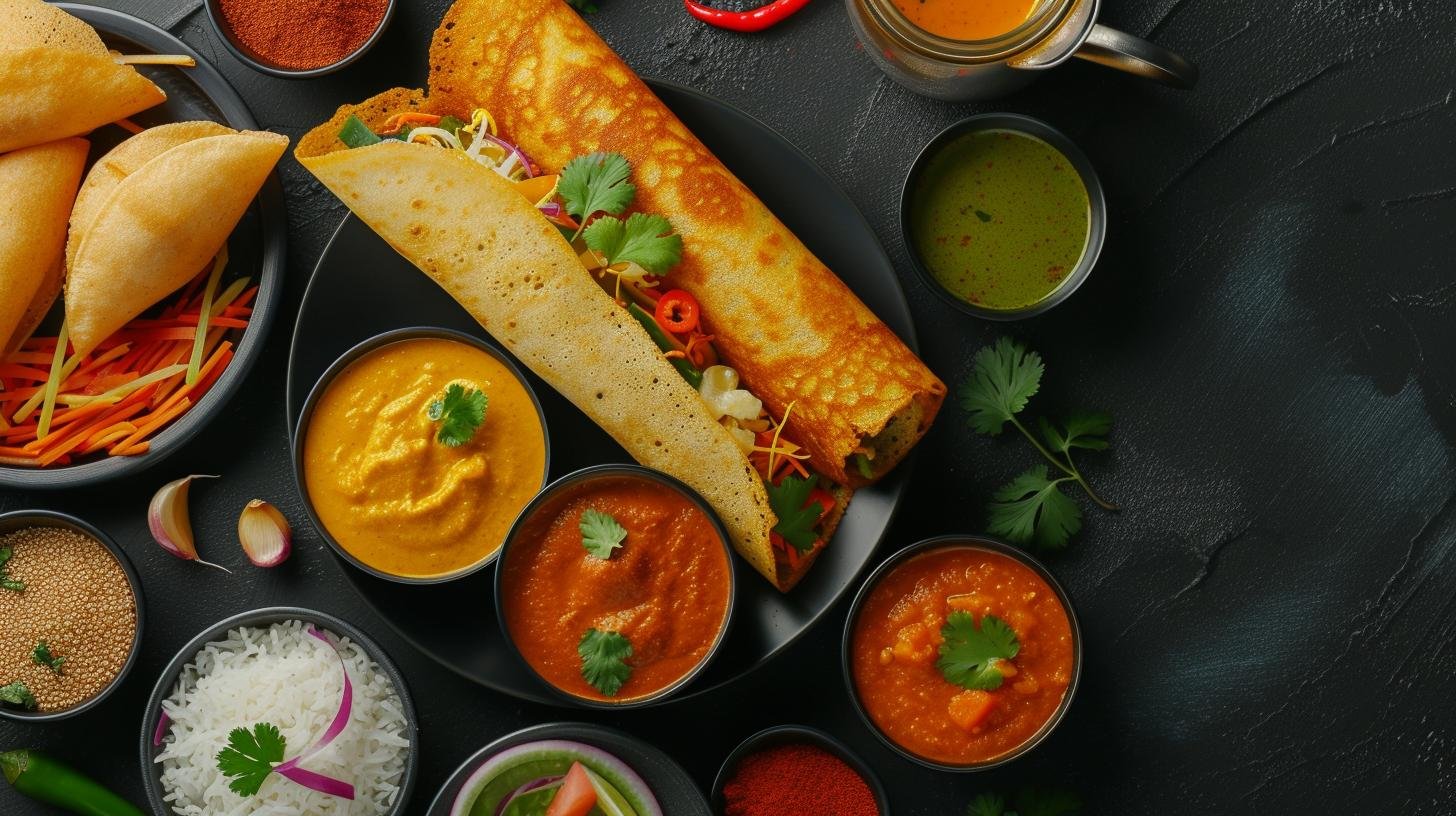Ragi dosa, also known as finger millet crepe, is a traditional and nutritious South Indian breakfast dish. This gluten-free and vegan dish is not only delicious but also packed with numerous health benefits. In this article, we will explore the recipe for making ragi dosa in Hindi, along with the health benefits of including ragi in your diet.
Ragi, or finger millet, has gained popularity in recent years due to its exceptional nutritional profile. It is rich in fiber, calcium, and other essential nutrients, making it a perfect addition to a healthy diet. Ragi dosa is a flavorful way to incorporate this superfood into your meals.
Not only is ragi dosa a tasty treat, but it also offers several health benefits. From aiding in weight management to regulating blood sugar levels, ragi dosa is a wholesome addition to any meal plan. Additionally, it is easy to digest and can be beneficial for individuals struggling with digestive issues.
Before we dive into the detailed recipe and variations of ragi dosa, let’s take a closer look at the key ingredients required to make this delectable dish. Understanding the components of ragi dosa will help you prepare and enjoy this traditional delicacy to its fullest potential.
The Health Benefits of Ragi
Ragi, also known as finger millet, is a highly nutritious grain that has been a staple in the diets of many Indian households for centuries. This ancient grain boasts an impressive array of health benefits, making it an excellent choice for those looking to incorporate more whole grains into their diet.
Rich in Nutrients
Ragi is packed with essential nutrients such as calcium, iron, and fiber. In fact, it contains three times the amount of calcium found in rice or wheat, making it an excellent source of this vital mineral. Additionally, ragi is high in iron, making it a great choice for those looking to increase their iron intake naturally.
High in Protein
For those following a vegetarian or vegan diet, ragi is an excellent source of protein. It contains an impressive amount of amino acids, which are the building blocks of protein and essential for maintaining and repairing body tissues.
Gluten-Free
One of the key benefits of ragi is that it is completely gluten-free, making it an ideal choice for those with celiac disease or gluten intolerance. It can be easily incorporated into a variety of dishes as a gluten-free alternative to other grains.
Regulates Blood Sugar Levels
Ragi has a low glycemic index, which means that it releases sugar into the bloodstream at a slow and steady rate. This can help regulate blood sugar levels and prevent spikes that can lead to insulin resistance and diabetes.
Aids in Weight Management
Due to its high fiber content, ragi can help promote feelings of fullness and prevent overeating. Additionally, the presence of dietary fiber helps improve digestion and may aid in weight management when consumed as part of a balanced diet.
Incorporating ragi dosa into your regular meal rotation is an excellent way to reap these health benefits while enjoying a delicious and traditional Indian dish.
Ingredients Required for Ragi Dosa
Ragi dosa is a popular South Indian dish that is not only delicious but also packed with health benefits. One of the key factors in making delicious ragi dosa is using the right ingredients. Here are the ingredients required to make ragi dosa:
Ingredients:
1. Ragi flour – 1 cup
2. Rice flour – 1/2 cup
3. Urad dal (black gram) – 1/4 cup
4. Fenugreek seeds – 1/2 teaspoon
5. Salt – as per taste
6. Water – as required for batter consistency
7. Oil or ghee – for cooking
These are the basic ingredients needed to make a simple and healthy ragi dosa at home. Ragi, or finger millet, is a rich source of calcium, iron, and fiber, making it an excellent addition to your diet.

When choosing these ingredients, it’s important to opt for good quality ones to ensure the best results. Freshly ground urad dal and fenugreek seeds can elevate the flavor profile of your ragi dosa.
Remember to adjust the salt as per your preference and use enough water to achieve the right consistency for the dosa batter. The right balance of ingredients is crucial for achieving a perfect ragi dosa that is crispy on the edges and soft in the center.
Now that you have gathered all the necessary ingredients, it’s time to proceed with the step-by-step instructions for making delicious ragi dosa at home.
Stay tuned for comprehensive step-by-step instructions on how you can make ragi dosa at home.
Step-by-Step Instructions for Making Ragi Dosa
To make delicious and healthy ragi dosa, follow these step-by-step instructions.
First, gather all the necessary ingredients for the batter: ragi flour, urad dal (split black gram), rice flour, water, and salt. It is important to use fresh and good quality ingredients for the best results.
Start by soaking the urad dal and rice flour in separate bowls for at least 4-6 hours or overnight. The longer you soak them, the better the fermentation process will be, resulting in a tastier dosa.
After soaking, rinse the urad dal and blend it with enough water to make a smooth paste. Do the same with the rice flour until it becomes a fine batter. Mix both batters together in a large bowl, adding ragi flour and salt to taste. Use your hands to mix well until all lumps are gone.
Cover the bowl with a clean cloth and let it ferment for 8-10 hours in a warm place. Once fermented, give it a good stir before making dosas.
Heat a non-stick pan or cast-iron skillet over medium heat and grease it lightly with oil. Pour a ladleful of batter onto the center of the skillet and spread it outward in a circular motion to form a thin dosa. Cook until golden brown on one side before flipping it over briefly to cook the other side.
These simple steps will help you create delicious and nutritious ragi dosas for you and your family to enjoy.
Tips for Perfecting the Ragi Dosa Batter
Perfecting the batter for ragi dosa is essential to achieving the perfect texture and taste. Here are some tips to help you perfect your ragi dosa batter:
1. Proper Fermentation: To ensure that your ragi dosa turns out light and crispy, it is important to ferment the batter well. Allow the batter to rest at room temperature for at least 8-10 hours, or overnight, to achieve a good fermentation.
2. Consistency: The consistency of the batter plays a crucial role in making the perfect ragi dosa. It should be neither too thick nor too thin. A slightly runny batter works best for getting those thin, lacy dosas.
3. Use Non-Stick Pan: When making ragi dosa, using a non-stick pan or a well-seasoned cast-iron skillet is important. This will prevent the dosas from sticking to the pan and make it easier to spread the batter evenly.
4. Adjust Salt: Remember to add salt just before making the dosas as adding it earlier can hinder the fermentation process. Adjust the amount of salt according to your taste preference.
5. Use Fresh Batter: Unlike regular dosa batter, ragi dosa batter does not store well for longer periods due to its high fiber content. It is best to use the fresh batter within 2-3 days of preparation for best results.
By following these tips, you can ensure that your ragi dosa turns out delicious and just like how it’s served in restaurants.
Experimenting with different techniques and ingredients can lead to exciting variations of this classic dish but remember these key pointers when working with ragi flour.

And remember – No two households make any recipe exactly alike. So do not be disheartened if your first (or second) batch does not turn out as expected.
Variations of Ragi Dosa
Ragi Dosa, a popular South Indian dish, is not only delicious but also incredibly versatile. There are numerous variations of this traditional dish that cater to different taste preferences and dietary needs.
One of the most common variations of ragi dosa is the inclusion of additional ingredients in the batter to enhance its flavor and nutritional value. For example, you can add finely chopped vegetables such as carrots, onions, and bell peppers to the batter to create a colorful and nutrient-packed dosa. These added vegetables not only contribute to the overall taste but also increase the fiber content of the dish.
Another popular variation is the use of different condiments and spices in the batter. You can experiment with adding ingredients like cumin seeds, curry leaves, or even grated coconut to infuse your ragi dosa with unique flavors. Additionally, for those who enjoy a bit of heat, adding chopped green chilies or a sprinkle of red chili powder can give your dosa an extra kick.
For individuals following a vegan or dairy-free diet, there are also variations that eliminate ingredients like yogurt or buttermilk from the traditional recipe. Instead, you can opt for plant-based alternatives such as almond milk or coconut milk to achieve a similar consistency in the dosa batter without compromising on flavor.
Finally, if you’re looking for a sweet twist on this savory dish, you can try making sweet ragi dosa by adding jaggery (unrefined sugar) or ripe bananas to the batter. This variation is perfect for those who have a sweet tooth but still want to benefit from the nutritional value of ragi.
Overall, these variations allow home cooks to get creative with their ragi dosa recipe while still enjoying a wholesome and nutritious meal.
| Variation | Description |
|---|---|
| Vegetable Ragi Dosa | Adds finely chopped vegetables such as carrots and bell peppers into the batter. |
| Spiced Ragi Dosa | Incorporates additional condiments and spices like cumin seeds, curry leaves, or grated coconut. |
| Vegan Ragi Dosa | Eliminates dairy products from the traditional recipe and replaces them with plant-based alternatives like almond milk or coconut milk. |
| Sweet Ragi Dosa | Includes sweet ingredients such as jaggery (unrefined sugar) or ripe bananas to satisfy those with a sweet tooth. |
Serving Suggestions for Ragi Dosa
When it comes to serving suggestions for ragi dosa, there are a variety of options to choose from that can complement the unique flavors of this nutritious dish. Here are some ideas for how to serve and enjoy ragi dosa:
Traditional Accompaniments
In traditional South Indian cuisine, ragi dosa is often served with coconut chutney, which adds a creamy and slightly sweet contrast to the savory and nutty flavor of the dosa. Additionally, sambar, a flavorful lentil-based vegetable stew, is another popular accompaniment that pairs well with ragi dosa.
Healthy Toppings
For those looking for a healthier option, topping your ragi dosa with thinly sliced vegetables such as tomatoes, carrots, and bell peppers can add freshness and crunch to each bite. You can also sprinkle some freshly chopped coriander leaves on top for added color and flavor.
Sauce and Dip Options
If you prefer a saucy or tangy accompaniment, consider serving ragi dosa with a side of tangy tomato chutney or spicy garlic chutney. These flavorful condiments can elevate the taste of the dosa and add an extra kick to each bite.

Fusion Flavors
For those looking to experiment with fusion flavors, you can get creative by incorporating different cuisines into your serving suggestions. For example, you can serve ragi dosa with a side of tzatziki sauce for a Mediterranean twist or pair it with avocado slices and salsa for a Mexican-inspired take on this classic Indian dish.
Overall, when it comes to serving ragi dosa, the possibilities are endless. Whether you choose to stick to traditional accompaniments or get creative with fusion flavors, the key is to find combinations that enhance the unique taste and texture of this wholesome and delicious dish. Try out different serving suggestions to discover your favorite way to enjoy ragi dosa.
Ragi Dosa Recipe in Hindi
Ragi dosa, also known as finger millet dosa, is a popular South Indian dish that is not only delicious but also incredibly healthy. This dish is made using ragi flour, which is rich in nutrients and has numerous health benefits.
Ragi dosa can be a great addition to your diet, especially if you are looking for a gluten-free and nutritious alternative to the regular dosa. In this section, we will provide you with a simple and easy-to-follow ragi dosa recipe in Hindi so you can enjoy this wholesome dish at home.
हिंदी में रागी डोसा बनाने के लिए निम्नलिखित सामग्री की आवश्यकता होती है:
- रागी आटा
- चावल का आटा
- सूजी
- हरा प्याज
- हरी मिर्च
- पुदीना पत्ते
- नमक
- पानी
To make ragi dosa, start by mixing ragi flour with rice flour and semolina in a bowl. Add finely chopped green onions, green chilies, mint leaves, and salt to the dry ingredients. Gradually add water to the mixture and stir until you achieve a smooth batter with pouring consistency.
Now, heat a non-stick skillet or dosa tawa over medium heat. Once the skillet is hot, pour a ladleful of the ragi dosa batter onto the center of the skillet and spread it evenly in a circular motion to form a thin layer.
Cook the ragi dosa for 2-3 minutes or until it turns golden brown and crispy on the edges. Drizzle some oil around the edges of the dosa and cook for an additional minute before carefully flipping it over using a spatula.
Once both sides are cooked to perfection, remove the ragi dosa from the skillet and serve hot with coconut chutney or sambar for a wholesome meal.
Conclusion and Final Thoughts on Ragi Dosa
In conclusion, Ragi Dosa is a delicious and nutritious dish that provides a range of health benefits. From its high fiber content to its rich source of calcium and other essential nutrients, including ragi in your diet can contribute to overall well-being. Its versatility also allows for various flavor combinations and toppings, making it a versatile option for any meal of the day.
The simplicity of preparing ragi dosa makes it an accessible dish for anyone looking to incorporate more whole grains into their diet. With just a few ingredients and a little bit of patience, you can whip up a batch of crispy, golden brown ragi dosas that are sure to satisfy anyone’s taste buds.
Whether you follow the traditional recipe or experiment with your own variations, the key lies in getting the batter consistency just right. Taking the time to ferment the batter can also enhance the flavor and texture of the dosas, resulting in an authentic and delicious outcome.
Ragi dosa can be enjoyed on its own or paired with your favorite chutneys, sambars, or other accompaniments. Its mild taste also makes it suitable for sweet fillings or toppings if you prefer a dessert-style dish. The adaptability of ragi dosa means that you can tailor it to suit your personal preferences and dietary requirements.
For those looking to try out this wholesome dish for themselves, there are many resources available with step-by-step instructions and tutorials on how to prepare ragi dosa at home. Whether you’re following a recipe in Hindi or another language, experimenting with different techniques will help you perfect your own unique version of this beloved Indian specialty.

